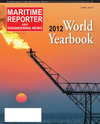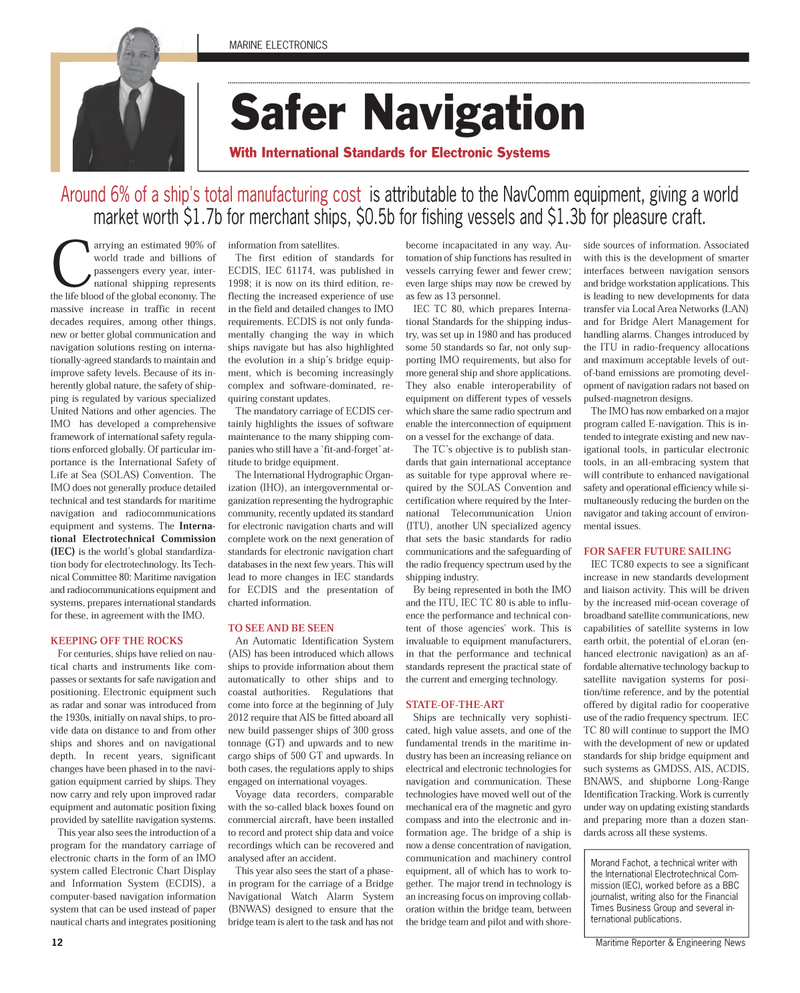
Page 12: of Maritime Reporter Magazine (June 2012)
Annual World Yearbook
Read this page in Pdf, Flash or Html5 edition of June 2012 Maritime Reporter Magazine
Carrying an estimated 90% ofworld trade and billions of passengers every year, inter- national shipping representsthe life blood of the global economy. The massive increase in traffic in recent decades requires, among other things,new or better global communication and navigation solutions resting on interna- tionally-agreed standards to maintain andimprove safety levels. Because of its in- herently global nature, the safety of ship-ping is regulated by various specialized United Nations and other agencies. The IMO has developed a comprehensive framework of international safety regula- tions enforced globally. Of particular im- portance is the International Safety ofLife at Sea (SOLAS) Convention. The IMO does not generally produce detailedtechnical and test standards for maritimenavigation and radiocommunications equipment and systems. The Interna- tional Electrotechnical Commission (IEC)is the world?s global standardiza- tion body for electrotechnology. Its Tech- nical Committee 80: Maritime navigation and radiocommunications equipment andsystems, prepares international standardsfor these, in agreement with the IMO. KEEPING OFF THE ROCKS For centuries, ships have relied on nau- tical charts and instruments like com-passes or sextants for safe navigation and positioning. Electronic equipment suchas radar and sonar was introduced from the 1930s, initially on naval ships, to pro- vide data on distance to and from otherships and shores and on navigational depth. In recent years, significant changes have been phased in to the navi- gation equipment carried by ships. They now carry and rely upon improved radar equipment and automatic position fixing provided by satellite navigation systems. This year also sees the introduction of aprogram for the mandatory carriage ofelectronic charts in the form of an IMOsystem called Electronic Chart Displayand Information System (ECDIS), acomputer-based navigation information system that can be used instead of papernautical charts and integrates positioning information from satellites.The first edition of standards for ECDIS, IEC 61174, was published in 1998; it is now on its third edition, re- flecting the increased experience of use in the field and detailed changes to IMO requirements. ECDIS is not only funda-mentally changing the way in which ships navigate but has also highlighted the evolution in a ship?s bridge equip- ment, which is becoming increasinglycomplex and software-dominated, re- quiring constant updates. The mandatory carriage of ECDIS cer- tainly highlights the issues of software maintenance to the many shipping com- panies who still have a ?fit-and-forget? at- titude to bridge equipment.The International Hydrographic Organ- ization (IHO), an intergovernmental or- ganization representing the hydrographic community, recently updated its standard for electronic navigation charts and will complete work on the next generation of standards for electronic navigation chart databases in the next few years. This will lead to more changes in IEC standardsfor ECDIS and the presentation ofcharted information.TO SEE AND BE SEEN An Automatic Identification System (AIS) has been introduced which allowsships to provide information about them automatically to other ships and tocoastal authorities. Regulations that come into force at the beginning of July 2012 require that AIS be fitted aboard all new build passenger ships of 300 gross tonnage (GT) and upwards and to new cargo ships of 500 GT and upwards. In both cases, the regulations apply to ships engaged on international voyages. Voyage data recorders, comparable with the so-called black boxes found on commercial aircraft, have been installed to record and protect ship data and voice recordings which can be recovered and analysed after an accident.This year also sees the start of a phase-in program for the carriage of a BridgeNavigational Watch Alarm System (BNWAS) designed to ensure that the bridge team is alert to the task and has notbecome incapacitated in any way. Au- tomation of ship functions has resulted invessels carrying fewer and fewer crew; even large ships may now be crewed by as few as 13 personnel. IEC TC 80, which prepares Interna- tional Standards for the shipping indus-try, was set up in 1980 and has produced some 50 standards so far, not only sup- porting IMO requirements, but also for more general ship and shore applications.They also enable interoperability of equipment on different types of vessels which share the same radio spectrum andenable the interconnection of equipmenton a vessel for the exchange of data. The TC?s objective is to publish stan- dards that gain international acceptance as suitable for type approval where re- quired by the SOLAS Convention and certification where required by the Inter- national Telecommunication Union (ITU), another UN specialized agency that sets the basic standards for radiocommunications and the safeguarding of the radio frequency spectrum used by the shipping industry. By being represented in both the IMOand the ITU, IEC TC 80 is able to influ- ence the performance and technical con-tent of those agencies' work. This is invaluable to equipment manufacturers, in that the performance and technicalstandards represent the practical state ofthe current and emerging technology. STATE-OF-THE-ART Ships are technically very sophisti- cated, high value assets, and one of thefundamental trends in the maritime in-dustry has been an increasing reliance onelectrical and electronic technologies fornavigation and communication. These technologies have moved well out of the mechanical era of the magnetic and gyrocompass and into the electronic and in-formation age. The bridge of a ship is now a dense concentration of navigation, communication and machinery controlequipment, all of which has to work to- gether. The major trend in technology is an increasing focus on improving collab- oration within the bridge team, betweenthe bridge team and pilot and with shore-side sources of information. Associated with this is the development of smarter interfaces between navigation sensors and bridge workstation applications. This is leading to new developments for data transfer via Local Area Networks (LAN) and for Bridge Alert Management for handling alarms. Changes introduced bythe ITU in radio-frequency allocations and maximum acceptable levels of out- of-band emissions are promoting devel- opment of navigation radars not based on pulsed-magnetron designs. The IMO has now embarked on a major program called E-navigation. This is in- tended to integrate existing and new nav- igational tools, in particular electronic tools, in an all-embracing system thatwill contribute to enhanced navigational safety and operational efficiency while si- multaneously reducing the burden on the navigator and taking account of environ- mental issues. FOR SAFER FUTURE SAILING IEC TC80 expects to see a significant increase in new standards development and liaison activity. This will be driven by the increased mid-ocean coverage of broadband satellite communications, new capabilities of satellite systems in low earth orbit, the potential of eLoran (en-hanced electronic navigation) as an af- fordable alternative technology backup to satellite navigation systems for posi- tion/time reference, and by the potentialoffered by digital radio for cooperative use of the radio frequency spectrum. IEC TC 80 will continue to support the IMOwith the development of new or updated standards for ship bridge equipment andsuch systems as GMDSS, AIS, ACDIS, BNAWS, and shipborne Long-Range Identification Tracking. Work is currently under way on updating existing standards and preparing more than a dozen stan-dards across all these systems. MARINE ELECTRONICSSafer NavigationWith International Standards for Electronic Systems Morand Fachot, a technical writer withthe International Electrotechnical Com- mission (IEC), worked before as a BBC journalist, writing also for the FinancialTimes Business Group and several in- ternational publications.Around 6% of a ship's total manufacturing cost is attributable to the NavComm equipment, giving a worldmarket worth $1.7b for merchant ships, $0.5b for fishing vessels and $1.3b for pleasure craft. 12Maritime Reporter & Engineering News MR June12 # 2 (9-16):MR Template 6/11/2012 9:14 AM Page 12

 11
11

 13
13
